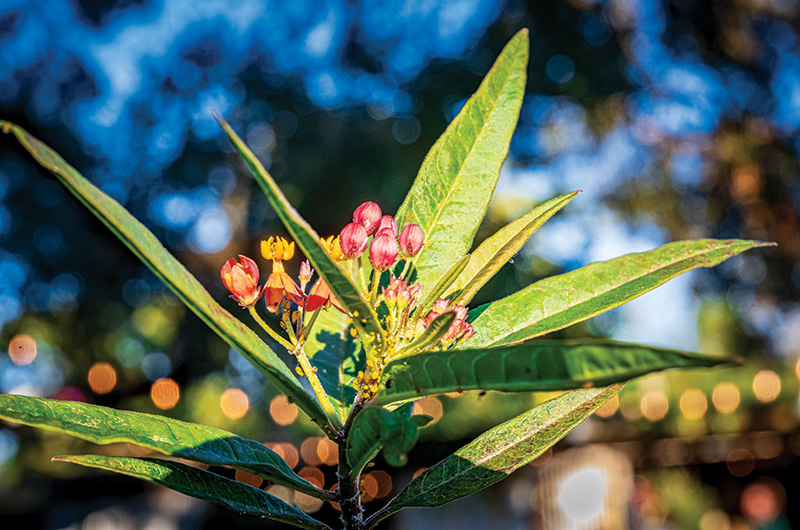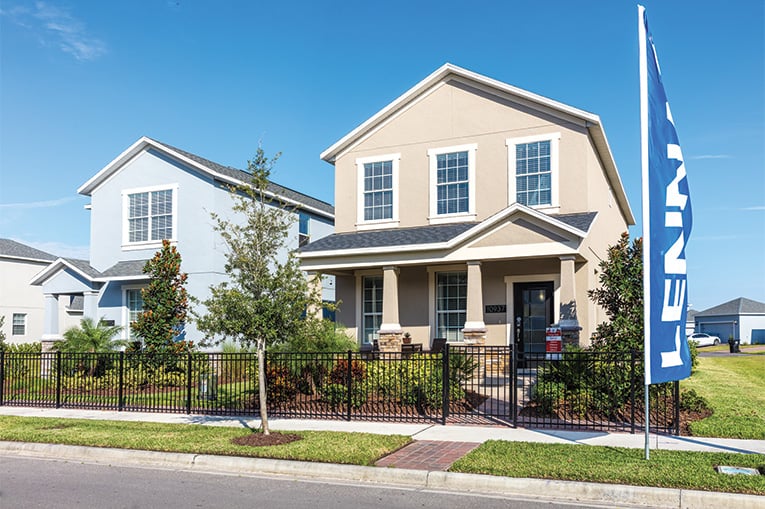The Dirt on Great Gardens
Assemble lush garden beds with help from our experts.
Towering Medjool palms, heavily manicured hedges adorned with blooms, groundcover Asian jasmine and shaped trees centered around a symmetrical grass-lined driveway are all part of the curb appeal of one of the Signature Landscape Contractors’ full-service outdoor makeovers that stands proudly in Winter Park.
“[That’s a] sophisticated, well-designed, large, complete outdoor space that Signature designed and installed,” says Andy Swanson with the landscaping company.
The grand, columned residence is complemented by an overlay of greenery on all sides—Oakleaf hollies, magnolia trees and junipers frame the home, accompanied by the standout azaleas and Knock Out roses at the estate.
Whether you are seeking a professional, full-scale outdoor transformation or creating a D.I.Y. lush butterfly garden at home, industry professionals agree that attention to detail, proper planning and the selection of the right plants are key to cultivating your perfect garden space.
Laying The Groundwork
When developing your ideal greenspace, Allison Palmer, owner of Palmer’s Garden & Goods, says it is best to start with a plan—a solid foundation. Foundation planting is what the family-owned garden center says should be your first step when setting up your lush landscape.
For example, when creating a bountiful front garden bed, you should start with planting shrubs and trees, known as foundation plants, against your house and then work your way forward with more color.
“On the foundation plantings, the shrubs and a lot of your greenery that you are going to keep year, after year, after year, definitely have a plan,” says Palmer. “Space out the plants accordingly because things grow so fast and big, you want to give them room to grow. And then when it comes to the perennials, the pollinators, I always like to have fun with that.”
Good foundation plants, says Palmer, include boxwood, loropetalum, viburnum and conocarpus, which all should be relatively low maintenance, given they have proper space to grow and thrive. After this, says Palmer, you can pick out a variety of flowers along the way, as these are less permanent and require more maintenance.
Swanson shared the same sentiment when it comes to planning. He says Signature considers all the factors of the climate before laying down the foundation.
“How big are the trees when they go in? What is the exposure? Is the canopy large and extensive for a property or is there no canopy? Where’s the North side? Where’s the South side?” Swanson asks when planning a property.
“The ability to design a space well is the understanding of that architecture,” he adds.
Setting your plants up for success is important. Palmer says the biggest thing she stresses to her customers is that, in Florida, you must enrich your soil due to its sandy nature.
“You’re starting from the roots up. So, the No. 1 most important thing is the planting medium,” says Palmer. “Our soil is really sandy and organic in Florida. When you’re planting in the ground, if you don’t enrich the soil with good compost and organic fertilizer, then a lot of the time, the plants won’t thrive.”

Signature Landscape Contractors looks to the architecture of the property when creating a landscape plan for its clients. ©Signature Landscape Contractors
Are You Low Or High-Maintenance?
Palmer says that most of her customers come to the garden center looking for pollinators, as they are environmentally friendly and very rewarding. Though they can be visually appealing, a lot of blooms come with a lot of maintenance.
“The more color, the more maintenance,” she adds. “So, if you didn’t put time into a butterfly garden, it would probably look like leaves after a while.”
If you’re ready to roll up your sleeves, she recommends pentas, blue daze, lantana and milkweed, which is the host plant for the Monarch butterfly. Native species like gaillardia, Walter’s viburnum and firebush are particularly well adapted to the local climate and offer colorful blooms.
“We always tell our customers, if you see it around, it probably does well here,” says Palmer. “So, if you see plumbago everywhere, it probably does well here… If you see a random weird plant that looks really cool that you’ve never seen around, it’s probably because it’s really hard to take care of. It can be done, but it’s probably not easily kept.”
Lower maintenance plants include philodendron varieties, like Xanadu and Selloum, which both grow well in low sun exposure areas, but can also handle high sun. Palmer said some bromeliads and Cardboard palms can also be planted and left with minimal maintenance.
Swanson, however, says his company focuses on bringing their client’s aesthetic vision to life, no matter if it is native or not. After installation, they continue to provide ongoing weekly maintenance, which includes the replacement of plants that are no longer thriving after completing their life cycle.

Allison Palmer, owner of Palmer’s Garden & Goods, says it’s best to start with a solid foundation when developing your ideal greenspace. Photo by Roberto Gonzalez
A Labor Of Love
Starting with healthy plants is essential for a flourishing garden. Palmer believes the reason her loyal client base is so loyal is because of their commitment to sourcing high-quality plants from vendors and providing excellent care from the nursery to your home.
Central Florida often goes through spans of heavy downpours, following long periods of no rain, posing unique watering conditions. Your plant’s water intake needs to be closely monitored to achieve success.
“For instance, I’m walking around the garden center and our plants are very wet. We turned off the irrigation this morning. It’s probably going to be off tonight [too],” she says, after a heavy rainfall. “More water is not always the answer.”
While your plant’s maintenance steps heavily depend on water, another key factor is sun exposure. Palmer says it is important to note how much sun the area you are looking to cultivate receives at different points in the day to help determine your care plan.
“During the quality maintenance, you’re either shaping those trees the way they should be, or you’re thinning them, or your canopy lifting them,” Swanson says, referring to Signature’s climate planning. “The landscape is normally designed to flow with that, and if not, then you make adjustments in the field for the client.”
Giving your plants attention and care, while providing key organic nutrients, is the best preventative measure you can take against plant decline, Palmer says. Keeping an eye on your plants to spot any abnormalities and treating them early is the best way to save your plant and your garden.
“Pests attack weak plants. If your plant is strong and healthy and well fertilized and well cared for, then it’s less likely to get pests or disease,” she says. “So, it’s just walking your garden, getting to know it, looking for anything that’s abnormal, you know, spots or bugs or anything that doesn’t seem right, and then treating it accordingly.”
You can always go back to the drawing board and rearrange things if your original plan is not blooming as intended, says Palmer. If all else fails, consulting professionals can always bring some clarity to the situation.
“If a plant is looking like it’s not thriving, it’s not growing or it’s kind of thinning out—you can take it and move it,” she says. “Ask a lot of questions too, when you’re at the garden center, so that the people here can help.”




